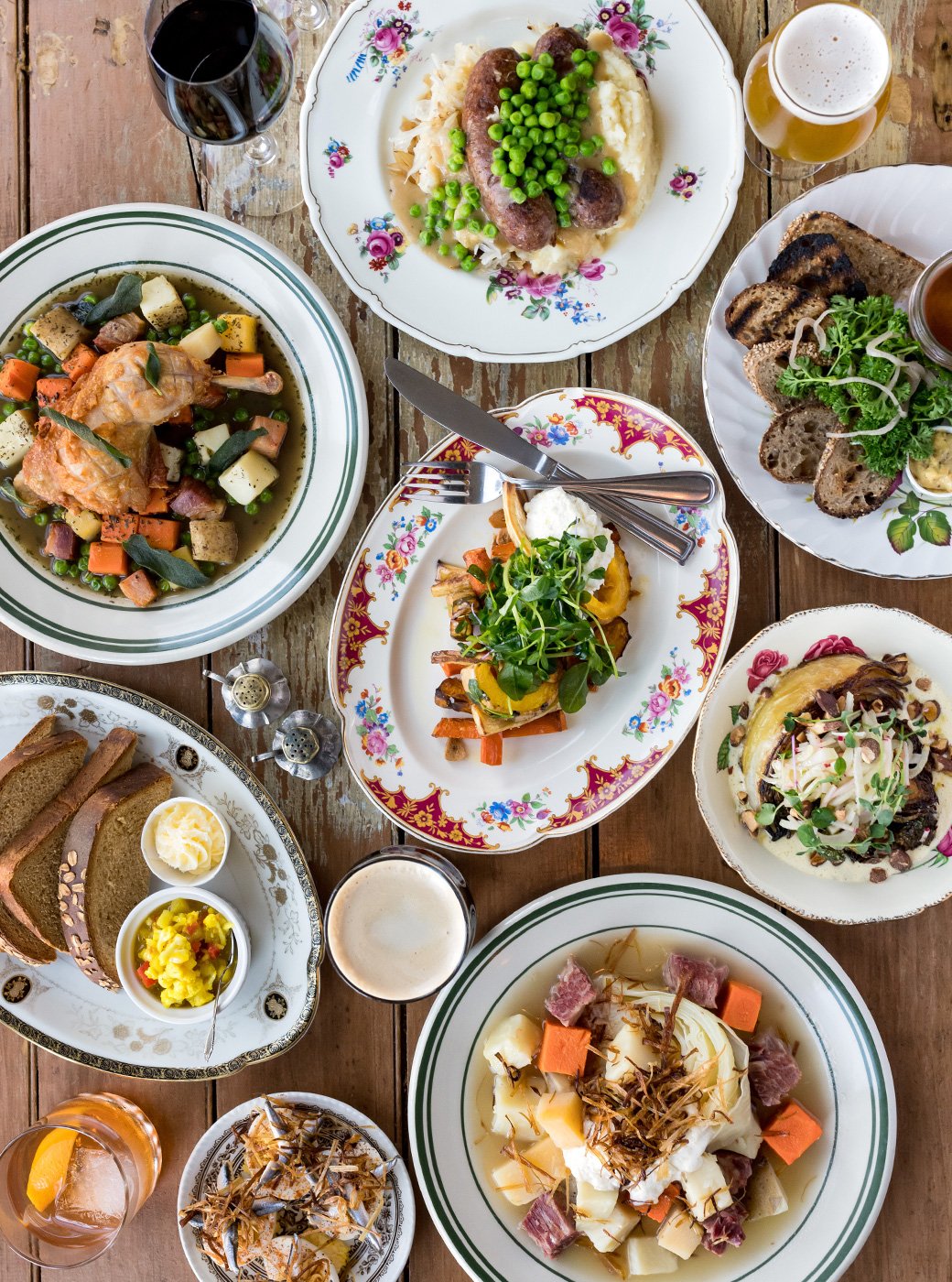The Narrows Public House
The Narrows Public House
Narrowly Escaping Defeat
BY LINDSAY WICKSTROM
PHOTOS MICHELLE DOUCETTE
“There must be something in the character of a people who could settle on the rockbound coast and sustain a living. Whatever the combination of determination, perseverance and simple honest gumption, we would all do well to try and emulate it.” – F. Leidemer
I noticed this quote on the wall by my booth at The Narrows after interviewing owners Tyson McDow and Myles Baldwin. It’s from the foreword of a non-disclosed book and just one piece of hyper-local memorabilia on the walls of The Narrows in which you could get completely lost. It seemed very apropos as I reflected on my conversation with McDow and Baldwin while tucking into a hot hamburger sandwich and a pint of local porter.
McDow and Baldwin opened The Narrows in March of 2022, and when I first walked through the doors, I couldn’t believe my eyes. If you can imagine for a second, the perfect pub…
A mishmash of repurposed and upcycled furniture, nostalgic artifacts from beloved former haunts like Tom’s Little Havana and Ginger’s Tavern, and two wood-burning fireplaces create the immediate impression of character and comfort. You could do a scavenger hunt for model schooners, taxidermy birds, and old Halifax photography or sit and read in a cozy corner. You don’t even have to bring a book; the pub is interactive, complete with stocked bookshelves. And it’s all wrapped up in a restored Victorian home built for a ship merchant in 1896.
Welcome to The Narrows Public House.
Located on Gottingen St., The Narrows gets its name from the narrow part of the harbour along which it resides. It survived the Halifax explosion—barely—but could have easily met the fate of so many historic homes around the city these days: demolition. Too expensive to fix up and too dilapidated for housing, so much of our history is knocked down to make room for shiny condos.
But there stands The Narrows: a living history and beacon of identity and hope.
Tyson McDow and Myles Baldwin
The pub might never have come to be if not for the determination, perseverance and simple honest gumption of McDow and Baldwin, as well, perhaps, as a bit of naivety. They might not have set out on this adventure if they knew how difficult it would be to re-zone and restore the house to commercial code.
McDow and Baldwin were not experienced developers or restaurateurs but were immersed in the restaurant industry while attending school. Baldwin originally started bussing tables to pay for his love of travel (he became enamoured with pub culture while visiting Wales). McDow had worked his way from “keg mover” to manager of the Library Pub in Wolfville while attending Acadia University. Despite their academic plans, both felt drawn to the restaurant industry and met while working at the Henry House.
Baldwin served up the idea to open a pub one day over a tennis match. The idea then incubated over many conversations at Tom’s Little Havana, where the friends would gather on their days off.
It was 2012, and the age of gastropubs, food trucks, and a renewed pride in traditional food was on the horizon. Ideas were in the air. McDow and Baldwin dreamed of a pub that would be the lovechild of their favourite places: the Henry House, the Library Pub, and Tom’s Little Havana. They were also profoundly inspired by dive bars, diners, and rustic cabins—a connectedness to the wilderness and rugged Maritime culture exemplified in homey blue-collar spaces rich in stories and history.
“Food doesn’t taste better than after a day of fishing, or whatever,” says McDow. “Sometimes I just want Moosehead and fries,” he adds.
McDow and Baldwin began looking for a commercial space but eventually found the old Victorian house. Originally, it was the home of Hugh Russell Silver, a Lunenburg-born merchant who was instrumental in financing the construction of the Bluenose and the Lord Nelson Hotel (of which he was the first acting president). He also commissioned the building of a schooner, the H.R. Silver (the house acquired its heritage designation as the H.R. Silver House). It housed other families and served different functions but operated as a Bed & Breakfast for 29 years.
McDow and Baldwin knew it would be a fixer-upper, but when they moved into the house in 2014, they didn’t realize the full extent of the work it would take.
“When we started talking with [city planners and development consultants] we realized what a big task this was going to be and how unlikely it was to succeed,” says McDow.
They realized that the only way they would qualify for a development agreement was to get a heritage designation. Typically, heritage designations go to buildings converted into professional buildings, generating revenue as doctors’ or lawyers’ offices, for example. The city has an incentive program towards this end, but until now, a commercial dining space has never been a recipient.
“What’s unique about our project is that you actually get to come into the heritage building,” says Baldwin, comparing it to certain parts of downtown where gutted houses only offer the facade of preservation. “So the creation of a pub is the promotion of living heritage. When we stop valuing that is when we are going to start losing our identity as a city, and it’s never been more important than right now”.
They had the community behind them, and council votes favoured their plan. Everybody wanted them to succeed.
“But we took the plans to a building code official,” says Baldwin, “and he was like: ‘It’s good to have a dream.’”
Getting such an old home to conform to code would be a nightmare. It would also cost tremendous amounts of money, which McDow and Baldwin did not have. But they weren’t so easily defeated. They brought on investors and started paying engineers.
They had a whole laundry list that included repointing the chimney, redoing the electrical and plumbing, re-landscaping the yard, repointing the foundations, replacing both roofs, ripping off the vinyl siding, replacing all of the rotten board, getting new gutters, and repainting the entire house.
They lived this way for almost seven years, residing in the house while holes were being smashed through the walls, looking for investors, starting a Kickstarter campaign, and getting friends to help with renovations, electrical and plumbing.
The pandemic was one last hurdle. McDow worked full-time at the Highwayman while Baldwin was at Battery Park. Suddenly, they were unemployed, and financial institutions were not interested in giving loans to the crippled restaurant industry. And there wasn't any government aid for projects yet to be up and running. The blessing they found in unemployment was more time to renovate themselves.
McDow and Baldwin are expressly thankful for so many people, without whom The Narrows might never have overcome these challenges: a host of Kickstarter supporters, handypersons, friends, and investors.
It takes a village.
“There must be something in the character of a people who could settle on the rockbound coast and sustain a living…”
Baldwin manages the front of house, while McDow deals with the menu. He hired Brendon Wagner from the Highwayman to head the kitchen and even hired a dedicated baker. It is a from-scratch operation, so everything from the Lunenburg sausage to the bread and desserts is house-made. The ingredients are local and seasonal. The menu hits heavy with vegetable dishes, and all beef and pork come from Vessel Meats. There is a noticeable emphasis on the truck stop, tavern, and traditional: from hot sandwiches topped with gravy and peas to the humble Dutch Mess (a haddock and potato dish).
“We’re approaching those classic recipes in a way that still has all the flavours,” says McDow. “We’re just taking restaurant techniques and skill and trying to revive them a little more.”
The end product is inspired but familiar and comforting, elevated but not pretentious.
For example, the south shore staple, Solomon Gundy (jarred pickled herring), is made with cured smelts. The boiled dinner features house-corned beef elegantly topped with crispy fried leeks and an apple & horseradish cream. The Hodge Podge features a pleasing arrangement of perfectly cooked vegetables atop a pool of cream, amplified with fresh dill.
“The way that we elevate [the food]… it’s not about big ideas or being clever,” says McDow. “It’s more about the craft. It’s about handling the ingredients. We’re handling stuff you would have at home in your pantry 50-60 years ago. We kind of challenge ourselves to use that palate of ingredients and make the food that we find in Nova Scotia cookbooks or through talking to people. Or to some extent, stuff that you would see in bars or taverns in Nova Scotia like fried pepperoni.”
An all-day menu features snacks and “pub classics.” The expanded menu starting at 3:30 p.m. includes homemade “square meals” served with molasses brown bread, butter and mustard pickles. Don’t sleep on the sticky toffee pudding for dessert.
There are rotating taps of local craft beer to wash down your meal, two cider taps, a couple of casked ales and a rotating kegged cocktail. The pub has three rooms, each with its own unique seating and vibe. It’s the kind of place I want to stay all day, sharing memories with friends. I’m always sad to leave.
McDow describes it as a “living room for the neighbourhood.”
But it is also a destination pub. It is off-the-beaten-path, far removed from the touristy streets of downtown. The Narrows isn’t the sort of place you wind up at by accident; you make a point of going because the experience is so rich and comforting. Anyone seeking the real Nova Scotian experience is well advised to add this to their itinerary. It is unapologetic in its humble traditional fare, from bologna to brown bread. A cold pint of ale is waiting there with your name on it. Find your new home away from home.










